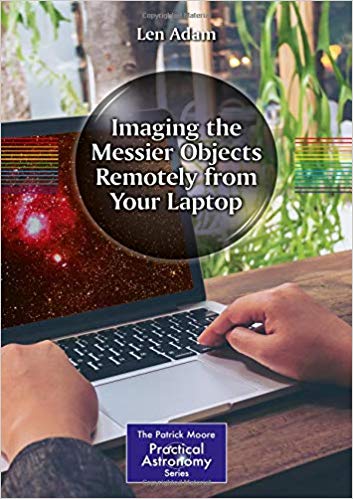Imaging the Messier Objects Remotely from Your Laptop Book Review
 This is not a book teaching you how to remotely connect your observatory to your home laptop or PC so you can control your telescope from the warmth of your lounge. I don’t think that topic would fill a book anyway. Instead this book is about renting telescopes around the world for imaging and controlling them from your laptop. Doesn’t have to be your laptop though it could probably be a desktop PC, Apple Mac, tablet or even smart phone.
This is not a book teaching you how to remotely connect your observatory to your home laptop or PC so you can control your telescope from the warmth of your lounge. I don’t think that topic would fill a book anyway. Instead this book is about renting telescopes around the world for imaging and controlling them from your laptop. Doesn’t have to be your laptop though it could probably be a desktop PC, Apple Mac, tablet or even smart phone.
I am amazed that more people don’t just rent a telescope for a couple of hours which is in a country with cloudless skies. You can probably rent a better telescope and imaging rig than you could ever afford, and you don’t have to maintain it or provide an observatory or garden shed to contain it. Or I wonder if people consider selling all their astronomy equipment and renting time on a remote scope instead or we just love looking at our scopes and we love the hands-on feel.
Anyway, the book, this is a chunky 520 pages book from Springer. Most of the book is filled with individual details on how to image each of the 110 Messier objects using remotely controlled telescopes. The author has used several different scopes and tells you which he used to image a certain M object. With each Messier object you get a constellation chart pinpointing the object, sometimes you get a negative image, but there is always the resulting image that was taken. You also get information like RA and Dec, Field of View, exposure time used, date taken, universal time, moon phase, scale of image and detailed information on what telescope was used this includes the mount used, aperture of scope, the CCD make and model, colour or mono, pixel size and the overall location of the telescope.
Before you get into the main body of the book with the list of Messier objects, the first 50 pages are all about remote telescopes. This section discusses the advantages of renting time and the different telescope sites as well as the individual telescopes and camera equipment (e.g. FOV etc) that were used at each site to take the images shown in the book. There is also information on using RA and Dec and how to use this information for inputting what you want to image on the remote site’s web site.
To be honest this book is more useful than you think, it’s not just for remotely controlled telescopes. This is good for home setups as well. Now you can look at the Messier object you want to image at home and see what the author imaged and what equipment was used and his results. If you have similar equipment at home, you can see what results you should also expect. Alternatively, if the author used a larger telescope on an object and you have a relatively small telescope then you can find out that object is not really going to image well for you.
Chapter 6 holds a quick reference image library for a list of NGC objects which is also great for reference when imaging. Most of the astronomical images are black and white. Images of telescopes are in colour and so are the constellation charts. Don’t forget that the remote telescopes will probably only take the images, it will then still be up to you to process the images and make them look good.
Overall
Some others may just see this book as 50 pages of information about renting telescope time with a big chunk of the book just listing 110 of the Messier objects and details about each image in turn. Overall though I really like this book as I think I would find it useful for my own imaging at home by using the Messier section for reference. I also welcome the first 50 pages of information on remote telescope sites as it could be the way forward for astronomers who don’t want to spend vast amounts of money on equipment or they may not have the space to store it or maintain it. Especially if you don’t have an observatory and you must drag all your equipment out every night and set it up every time you want to use it, that can become tedious – I know first-hand. Another reason I think for using a remote telescope is that astrophotography has become very popular since 2010 and most objects in the sky have been imaged so many times (just Google some!). So, you need to think about imaging with bigger telescopes or in a different way with new colour palettes for example, remote telescopes let you do this with minimal cost.
Where can I buy Imaging the Messier Objects Remotely from Your Laptop?
You can buy Imaging the Messier Objects Remotely from Your Laptop from Amazon UK
